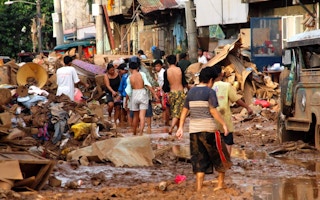Today’s cities face a myriad of challenges that include ageing populations and infrastructure, heatwaves, waste management and mass migration into urban centres.
To continue reading, subscribe to Eco‑Business.
There's something for everyone. We offer a range of subscription plans.
- Access our stories and receive our Insights Weekly newsletter with the free EB Member plan.
- Unlock unlimited access to our content and archive with EB Circle.
- Publish your content with EB Premium.
Asia Pacific—where 55 per cent of the total population lives in cities—is particularly vulnerable as climate change kicks into high gear in the decades ahead, and will only grow increasingly prone to stresses ranging from water shortages to soaring temperatures, and shocks like the recent devastating floods in the southern Indian state of Kerala.
Such urban issues can no longer be ignored, and should galvanise local governments to make urban resilience a top priority, says Andrew Salkin, senior vice president at 100 Resilient Cities (100RC), a non-profit organisation set up and suppported by The Rockefeller Foundation that helps cities address social, physical and economic challenges.
Resilient cities are better able to provide their citizens with liveable physical spaces and essential functions such as healthcare, education, nutrition and safety regardless of the shocks and stresses they face, he adds.
Speaking to Eco-Business, Salkin says that Asia Pacific has the chance to avoid the infrastructural issues prevalent in other parts of the world, including poor transport systems, inefficient waste management and inadequate housing design. But to do so, the region must align policies and urban planning with resilience strategies, and draw on lessons from developed countries.
“Asia Pacific is one of the most rapidly urbanising regions in the world,” he tells Eco-Business. “It is crucial that governments act now or they will miss the lessons that have been learned in other cities around the world.”
However, there are challenges. One critical obstacle to conceptualising viable resilience strategies is that local governments often do not know what the most pressing urban issues are, Salkin notes, pointing to the lack of data in many cities in the region. This could be due to an insufficient number of studies conducted, particularly in areas of flood risk and urban transport, he adds.
“
Data is a critical piece of information that you need to make good policy and management decisions, and it is also crucial when sharing with your citizens why you are taking certain decisions.
Andrew Salkin, senior vice president, 100 Resilient Cities
“Data is critical if you want to make good policy and management decisions, and it is also crucial when sharing with your citizens why you are taking certain decisions,” he elaborates.
“The data gaps in the region are in some cases immense, and they can be catastrophic if cities make financial decisions without any statistical basis,” Salkin continues. “Cities need a clear idea of what their most pressing problems are before they can develop sound resilience strategies to solve them.”
To bridge such data gaps, 100 Resilient Cities collaborates with governments to conduct studies on critical urban challenges and engages citizens in urban planning.
In Bangkok, for example, data was collected to develop a better understanding of the city’s flood risk and put together a flood management strategy for the Thai capital, according to a recent report by 100 Resilient Cities.
By analysing Bangkok’s infrastructure, land use and land elevation, and the climatic and socio-economic conditions of the selected areas, city planners understand how these systems are interconnected and likely to impact one another in the face of shocks and stresses, says Salkin.
Building resilient cities together
Another challenge is the fact that budgets in many of parts of the region are small, Salkin notes. According to the Asian Development Bank, the investments required to meet Asia Pacific’s infrastructure needs alone exceed $1.7 trillion per year when climate change mitigation and adaption costs are taken into account.
But Salkin tells Eco-Business: “Buildings and infrastructure do not necessarily have to be built by governments; they can be built because of governments.”
Governments must engage communities, unlock private capital and regulate private investment, he shares. For instance, regulators can mandate specific types of infrastructure and housing designs, which turns the private sector into a key partner in building urban resilience.

Andrew Salkin, senior vice president, 100 Resilient Cities. Image: 100RC
Or, authorities could rule that utilities in buildings in flood-prone areas must be installed on the upper floors so that during a flood, water can pass through the first floor without significantly inhibiting the inhabitant’s everyday activities, he says.
Furthermore, local governments in Asia Pacific, home to 17 of the world’s 28 megacities, can engage start-ups, venture capitalists and communities to help tackle urban problems. This is a sector able to deliver the technological innovation required to improve lives, and businesses, investors or entrepreneurs who do this well will have many business opportunities to choose from, he shares.
Salkin also emphasises the need for cities to learn from each other, pointing out that many cities around the world and particularly in the region share similar challenges like rising temperatures, flooding, air pollution, traffic congestion and overcrowding.
He says: “There are lessons about these issues that have been learned locally, but they have not been shared globally. Collaborations between cities will enable them to create scaleable solutions to tackle these challenges.”








